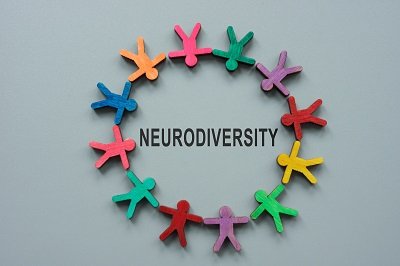What is Neurodiversity?

Embracing Neurodiversity: Celebrating Differences
By: Erin Rolando
What is Neurodiversity?
Neurodiversity is a concept that recognizes and celebrates the natural variation in neurological differences among individuals. It acknowledges that conditions such as autism, ADHD, dyslexia, and others are simply variations of the human brain, rather than disorders that need to be Fixed or cured. Embracing neurodiversity means valuing the unique perspectives and abilities that neurodivergent individuals bring to our society.
Neurodiversity Definitions: Merriam-Webster Dictionary
1. individual differences in brain functioning are regarded as normal variations within the human population
2. the concept that differences in brain functioning within the human population are normal and that brain functioning that is not neurotypical should not be stigmatized
3. the inclusion in a group, organization, etc. of people with different types of brain functioning
Etymology:
NEURO + DIVERSITY, after BIODIVERSITY
First Known Use: 1998
The Neurodiversity Movement
The neurodiversity movement is a social and civil rights movement that advocates for the acceptance and inclusion of neurodivergent individuals in all aspects of society. It seeks to challenge stereotypes, eliminate discrimination, and create a world where neurodivergent individuals can thrive. The movement highlights the strengths and talents of neurodivergent individuals, emphasizing their valuable contributions to diverse fields.
The Misuse of Neurodiversity as a Buzzword
While the neurodiversity movement has made significant progress, there is a risk of neurodiversity being misused as a buzzword. Some companies and organizations claim to support neurodiversity without genuinely embracing it. This can lead to tokenistic efforts that do not address the core issues, such as inclusive employment practices and accessible education. It's crucial to distinguish between genuine commitment to neurodiversity, token acknowledgment, and hypocrisy.
The concept of neurodiversity has a relatively recent history but has roots in earlier disability rights movements. Here's a brief overview:
Origins in the Disability Rights Movement
The neurodiversity movement emerged in the late 20th century, drawing inspiration from the broader disability rights movement. It found common ground with earlier civil rights movements that advocated for social inclusion and equal rights.
Coined Term
The term "neurodiversity" was coined by Australian sociologist Judy Singer in the late 1990s. She used it to describe the idea that neurological differences, such as autism and ADHD, should be recognized and respected as natural variations of human diversity.
Shift from Medical to Social Model
Neurodiversity represents a shift from the medical model of disability to the social model. It emphasizes that disability is not solely an individual's medical problem but often results from societal barriers and discrimination.
Advocacy and Awareness
The neurodiversity movement gained momentum in the early 21st century through online communities, blogs, and advocacy groups. It aimed to raise awareness about neurodiversity and challenge stigmatizing and pathologizing views of neurological differences.
Influence on Policy and Education
The principles of neurodiversity have influenced policies and practices in education and employment. It has led to a greater focus on inclusion, accommodations, and acceptance of neurodivergent individuals in various spheres of life.
Expanding Scope
Over time, the neurodiversity concept has expanded to include a wide range of conditions, going beyond autism to encompass conditions like ADHD, dyslexia, Tourette syndrome, and more. The "neurodiversity umbrella" recognizes the diversity of neurotypes.
Ongoing Evolution
The neurodiversity movement continues to evolve and adapt, addressing new challenges and advocating for the rights and dignity of neurodivergent individuals. It has played a crucial role in changing societal perceptions of neurological differences.
Overall, the history of neurodiversity is one of a growing understanding and acceptance of neurological differences, challenging stereotypes, and advocating for inclusivity and equal opportunities for all individuals, regardless of their neurotype.
Importance of Genuine Support
Genuine support for neurodiversity involves creating inclusive workplaces, educational environments, and communities where neurodivergent individuals can flourish. It means providing reasonable accommodations, fostering understanding, and promoting acceptance. When we truly embrace neurodiversity, we unlock the potential of diverse minds, leading to innovation, creativity, and a more equitable society.
Understanding neurodiversity is crucial when considering how to genuinely support individuals with diverse neurological experiences in our society. The neurodiversity umbrella covers a wide spectrum of conditions, and the neurodiversity movement advocates for genuine inclusion and acceptance. While the term may be misused as a buzzword at times, the true importance lies in creating an inclusive world where all individuals, regardless of their neurological differences, can thrive and contribute meaningfully.
Neurodiversity Affirming Practices
Neurodiversity-affirming practices encompass a range of approaches aimed at recognizing and celebrating the diversity of neurological experiences in individuals. These practices reject the notion of pathologizing or attempting to "normalize" neurodivergent traits, such as autism, ADHD, dyslexia, and others. Instead, they emphasize inclusion, understanding, and support. This includes providing reasonable accommodations in educational and workplace settings, such as extended time for tasks, creating sensory-friendly environments, and promoting clear and direct communication to better meet the needs of neurodivergent individuals.
Furthermore, neurodiversity-affirming practices encourage flexibility in learning and problem-solving approaches, as well as collaboration. Education efforts in awareness and acceptance are crucial to reduce stigma and foster empathy among peers and the wider community. Ultimately, these practices aim to create a more inclusive society where individuals of all neurotypes can thrive and contribute to their fullest potential.



